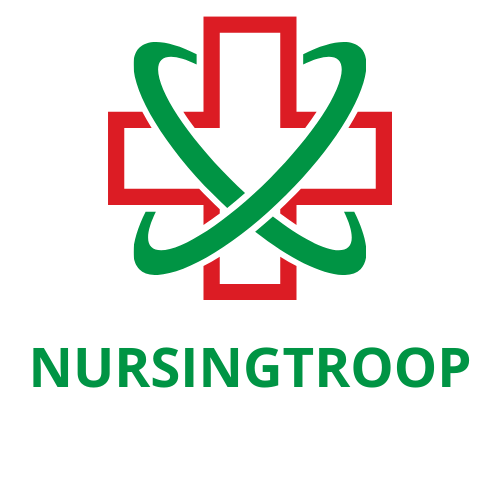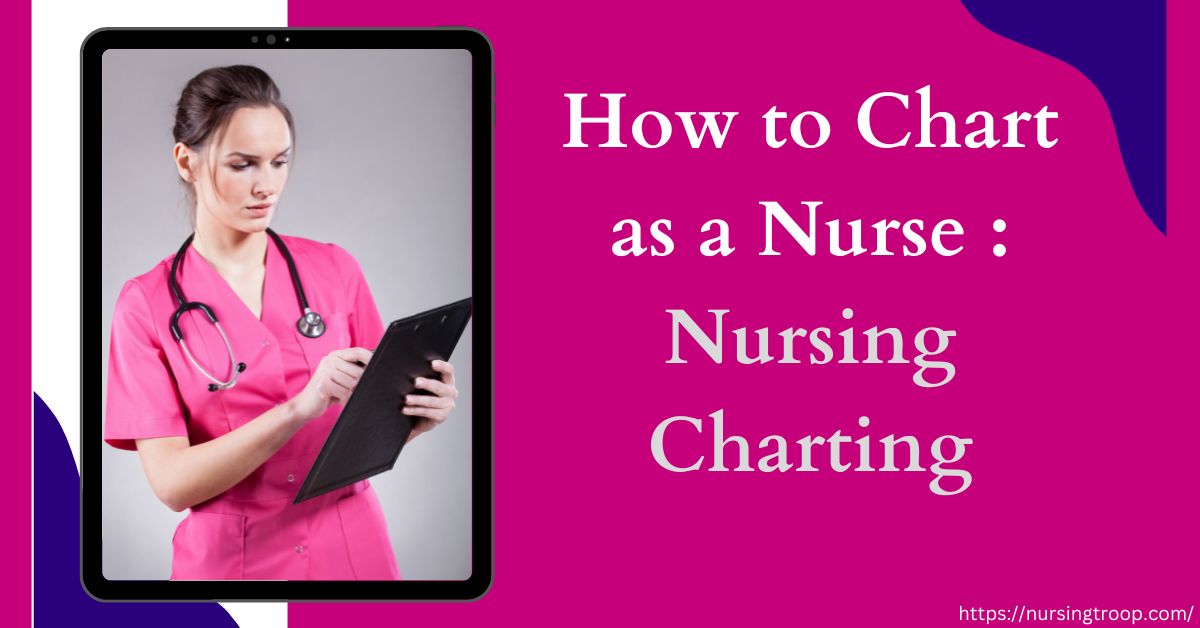Patients are the nurse’s main priority, and they make every potential effort to fulfill their duties. Nurses have to deal with many patients every day, and it is difficult to remember every patient’s vital points. In this situation, documentation plays a key role. Charting is one of the documentation methods to note down all the vital points of every patient, which is very important for nurses. Documentation must be accurate and comprehensive, as this will help them in medical decision-making.
Table of Contents
What is Charting in Nursing?
Nursing charts document patient information, including symptoms, medical history, treatments, medications, and other vital details. Charting is a critical part of any nurse’s job because it helps ensure quality patient care. Through careful charting, nurses can track a patient’s progress, provide proper care and treatment plans, and ensure that all medical professionals involved in a patient’s care are on the same page. Charting also helps protect patients and hospitals in case of a lawsuit or other legal issues.
Charting is typically done on an electronic health record (EHR) system. This software makes it easier for nurses to track and update patient information on time. Nurses can also quickly search through an EHR system to find the necessary information about a patient’s care. Nurses must become familiar with their hospitals’ charting systems to ensure they document correctly and that all the information is up-to-date and accurate.
How to Chart as a Nurse?
Charting nursing care is an essential component of quality patient care. It helps ensure that all information relevant to a patient’s treatment and progress is accurately documented in the medical record. The task of charting can be daunting for nurses, but there are a few tips to make this process easier and more efficient:
1. Have all necessary documentation ready before starting the charting process. Gather all patient notes, test results, and any other relevant records.
2. Only document information that is pertinent to the patient’s care. Avoid using superfluous language in your charting entries.
3. Pay attention to details – documenting accurate dates and times of treatments or changes in patient condition is essential.
4. Use standardized language when possible for consistency and clarity. This will help ensure that other healthcare professionals can read the charting and understand it easily.
5. Include all relevant information such as vital signs, medications administered, treatments provided, or any change in a patient’s condition. It is essential to include the reasons behind any treatments or changes in care.
6. Chart as soon as possible after providing care. It will help ensure that all relevant information is accurately documented, fresh in your mind, and provide a complete picture of the patient’s condition.
What is the Importance of Charting?
Charting is vital to nursing, allowing nurses to deliver the best care possible for their patients. Nurses must follow their hospitals’ charting protocols to ensure that patient safety and quality of treatment & care are not compromised. Charting also helps nurses stay organized and provides a comprehensive view of the patient’s medical history. In addition, adequately charted data can help healthcare professionals quickly identify potential problems or changes in the patient’s condition.
This could be vital in saving a patient’s life in an emergency. Charting also helps protect nurses if they are ever faced with a malpractice suit by providing proof that appropriate care was provided. Nurses must be thorough and accurate when charting, as discrepancies could risk a patient’s life. By following the proper charting techniques, nurses can ensure the best possible patient care while maintaining legal protection.
What are the 5 Methods of Documentation in Nursing?
1. Narrative/Source-Oriented Method: This method uses free text to document the patient’s care chronologically from the beginning to the end of their hospital stay.
2. Problem-Oriented Method: This method uses problem lists, data collection, and interventions to document a patient’s care.
3. Charting by Exception Method: This method focuses on documenting only those items that are outside of the established norm or represent a change in care, as opposed to documenting every aspect of patient care.
4. Computerized Provider Order Entry (CPOE): This electronic system for ordering and tracking medications, tests, and treatments.
5. Standardized/Protocol-Based Method: This method uses predetermined protocols to document patient care, such as pain management or wound assessment.
By using some of these documentation methods, nurses can ensure that accurate and complete patient care information is recorded in the medical record. This is essential for providing quality patient care and obtaining optimal outcomes.
What Mistakes Happen in Charting Nursing Care?
Charting errors can seriously affect nurses, patients, and healthcare organizations. Common charting mistakes include:
1. Not documenting all relevant information, including vital signs, treatments provided, medications administered, patient condition changes, or any other relevant info.
2. Not updating the chart when treatments change, or new information is acquired.
3. Failing to document why a specific course of action was taken, or changes were made in the patient’s care plan.
4. Not using standardized language when possible makes it difficult for other professionals to understand the charting entries.
5. Document irrelevant information that does not add value to the patient’s care or support the treatment plan.
6. Not charting on time can result in complete or accurate information being included in the patient record.
By avoiding these mistakes and following best practices for charting, nurses can ensure that their patients’ records are accurate and up-to-date.
Tips to Avoid Mistakes in Charting Nursing Care
1. Take the time to read and understand all relevant documentation before charting.
2. Follow established guidelines for documenting the care provided, such as using standardized language when possible.
3. Record changes in a patient’s condition or treatments as soon as they occur so that information is accurately documented.
4. Enter timely, accurate, and complete information in the patient records to ensure that other professionals can understand the care provided.
5. Use a system or program to alert you if conflicts exist between charted data and existing medical record entries.
By following these tips, nurses can avoid mistakes in charting nursing care and ensure their patients receive the highest quality of care.
Is Charting Hard in Nursing?
Charting can be challenging for nurses, especially with the increasing amount of data that needs to be documented. The process can be made more accessible by following best practices and using available technology tools. Using a computerized charting system can help streamline the documentation process by automatically populating fields, reducing errors, and making charting more efficient.
How do You Write a Nursing Chart?
When charting, nurses should document all relevant information, including assessments, treatments provided, medication administration, patient condition changes, or any other pertinent information. Other important information to include in the nursing chart includes:
1. The date and time of each assessment, treatment, or medication administered
2. An explanation for why a specific course of action was taken and how the patient responded
3. The names of any medical personnel who were involved in the care
5. The names of a family person who reported any issues along with the issue
6. Any complications or side effects experienced by the patient
7. Results from diagnostic tests, lab work, consultation notes, etc.
8. Documentation that outlines the patient’s plan of care
By including all relevant information in the chart, nurses can ensure that their patients receive quality care and that the nursing staff has a complete picture of each patient’s condition.
Frequently Asked Questions
Q: Is charting necessary for nurses?
A: Yes, charting is an essential part of nursing care as it provides an accurate and detailed record of the care provided to each patient. Charting helps ensure that nurses provide quality care and allows other healthcare professionals to understand the history and progress of each patient.
Q: What are the benefits of computerized charting?
A: Computerized charting systems offer several advantages over traditional paper-based charting, such as reducing errors, streamlining data entry, and providing accurate and up-to-date information. They also allow for easier records retrieval and provide real-time access to patient information.
Q: What are the risks associated with charting?
A: Although charting is essential to providing quality care, it can also present risks, such as confusing or conflicting information that may lead to misdiagnosis and incorrect treatments. Nurses must double-check all charting entries to ensure accuracy and follow best practices for documenting patient care.
Final Thoughts
Charting is a critical component of nursing practice, and nurses must take the time to document all relevant information accurately and completely. By following best practices for charting, using technology tools, and including all pertinent information in the nursing chart, nurses can ensure that their patients receive quality care. If you have questions about optimizing your charting process or need additional help, please contact us via email or fill the contact form.
Mrs. Marie Brown has been a registered nurse for over 25 years. She began her nursing career at a Level I Trauma Center in downtown Chicago, Illinois. There she worked in the Emergency Department and on the Surgical Intensive Care Unit. After several years, she moved to the Midwest and continued her nursing career in a critical care setting. For the last 10 years of her nursing career, Mrs. Brown worked as a flight nurse with an air ambulance service. During this time, she cared for patients throughout the United States.

